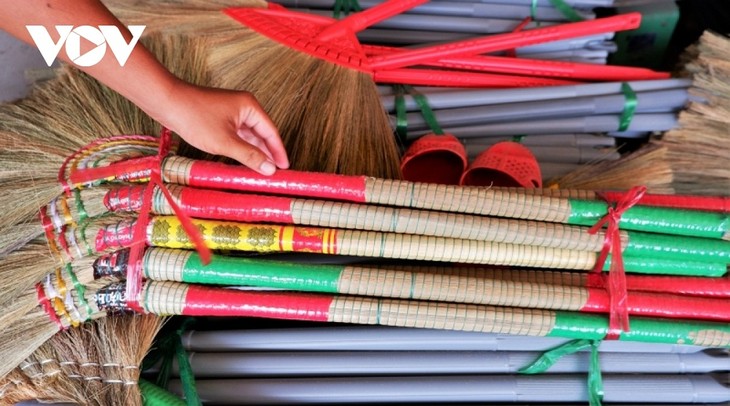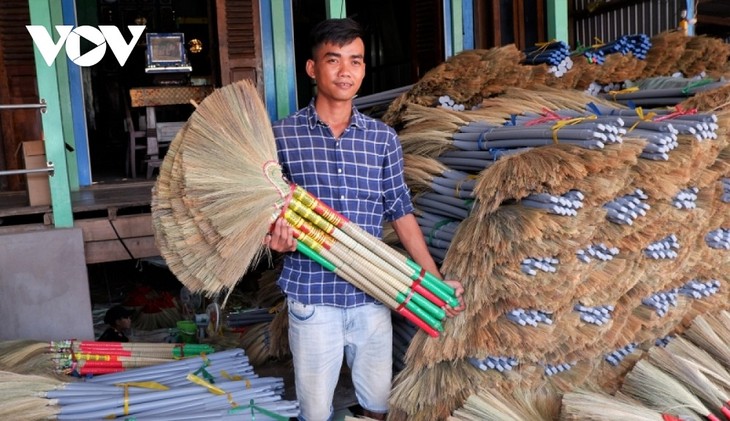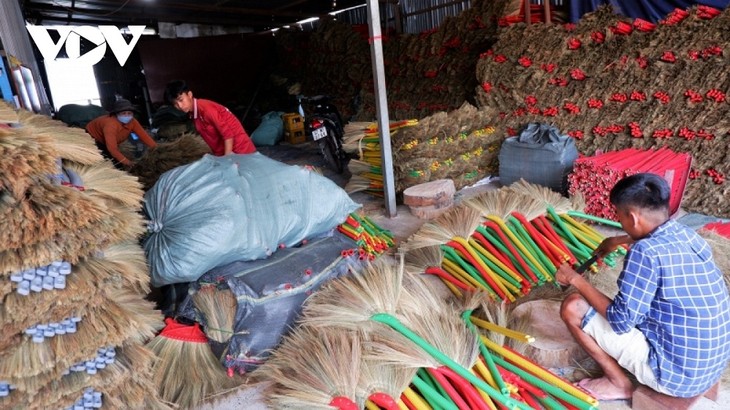(VOVWORLD) -Con Nho, a broom-making village in Phu Binh commune, Phu Tan district, was recognized as a handicraft village in 2006 by the People's Committee of An Giang province. Investment has been made to expand the craft.
 Broom-making facilities diversify designs to meet market demand. Broom-making facilities diversify designs to meet market demand. |
Grass broom making has been existing in Con Nho village, mainly in Binh Thanh hamlet, for decades. Village elders say that, in the past, broom grass, or reed grass, grew profusely in Con Nho. During the flood season, the locals picked blades of grass, dried them, and tied them into brooms for home use. The craft of broom-making gradually became a means of livelihood for some local families. 350 households in Con Nho are now engaged in the craft and employing more than 1,000 workers.
There are two types of brooms – reed brooms and grass brooms – and many designs, such as curtain brooms which are wound with colorful flat plastic fibers, laminated brooms which are wrapped with ribbed wire, and plastic handle brooms.
A broom costs about 1 USD. The village produces about 200,000 brooms per month, which are sold both in Vietnam and abroad.
 Dao Trung Hieu introducing several types of brooms his workshop is making. Dao Trung Hieu introducing several types of brooms his workshop is making. |
Dao Trung Hieu, who heads one of the largest workshops in Con Nho, said that his main market is Cambodia, which buys 70% of our brooms. The other 30% is divided equally between the domestic market, Indonesia, and Thailand.
“Depending on the number of orders, there can be four to five cargo trucks per week. The peak season is the months close to Cambodia's New Year holiday, when we receive more orders and need 60 to 70 workers per day,” said Hieu.
Con Nho villagers say they now use machines to make the brooms more durable and beautiful, but most of the production steps are still manual. Ha Vy, a broom maker in Phu Binh commune, told VOV that she used to work at a restaurant in Binh Duong province. “Then I returned to my hometown to work. Now I've been making brooms for more than a year. The income is OK,” said Vy.
Doan Thi Nhu Y, a local resident, recalled, “In the past I stayed at home and helped my mother look after my younger siblings. Now I work as a broom maker and have stable work, earning 212-254 USD a month.”
In the past, reed grass was the only material used to make brooms and it was only available during the flood season. Now brooms are also made from a grass species called Tiger grass (Thysanolaena latifolia), which is imported from Vietnam’s central provinces. Tiger grass, which grows all year round, provides an abundant source of raw materials for brooms.
Cao Van Muc, the owner of a broom-making workshop in Binh Thanh hamlet, said in the past, the locals collected reed grass for broom-making in the Mekong Delta provinces of Ca Mau and Kien Giang, but this material was quickly depleted.
“Then we had to buy Tiger grass from the central region. I make 1,000 brooms a day, each of which makes a profit of 40 cents after deducting the cost of materials and labor,” said Muc.
 Each month the Con Nho broom-making village supplies 200,000 products of various kinds to the market. Each month the Con Nho broom-making village supplies 200,000 products of various kinds to the market. |
Phu Binh commune People's Committee and Phu Tan district branch of the Bank for Social Policies have helped local broom makers obtain preferential loans with low interest rates.
According to Ho Thanh That, the local craft village manager, craft villages have generated jobs for the locals, helping to ensure social security. Anyone who works in a craft village is no longer considered poor or near-poor.
“Phu Binh commune and An Phu district plan to build a brand for our craft village and establish a cooperative to link broom-making households together so Phu Binh brooms can be sold at a higher price,” said That.
Brooms are now produced all year round, creating a stable income for the villagers and contributing to the preservation and development of this traditional craft and the craft village culture.